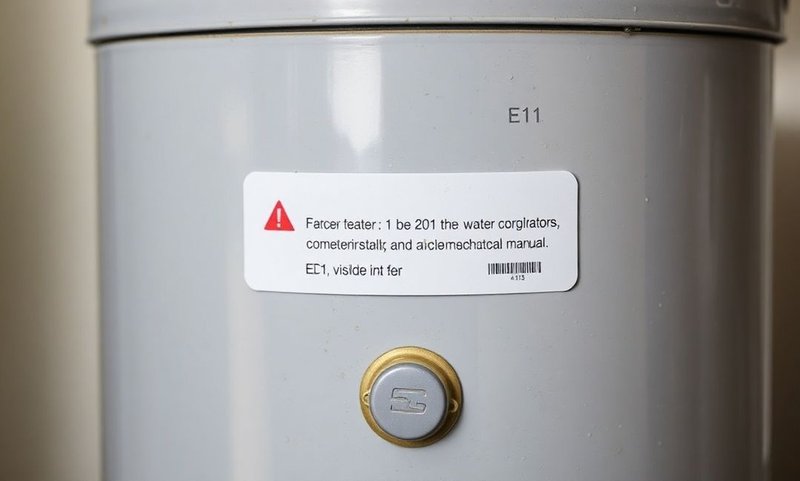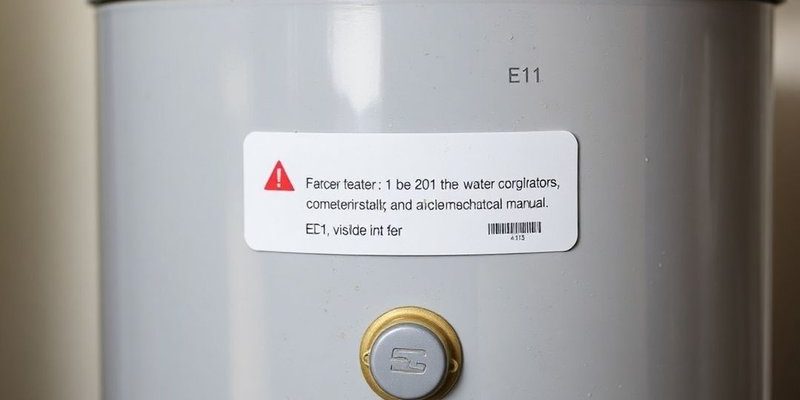
So, what exactly does Error Code E1 mean? In straightforward terms, it’s your water heater’s way of waving a little flag to alert you that there’s an issue with the inlet thermistor, a crucial component that measures water temperature. Think of the thermistor as a weather station within your water heater, keeping tabs on temperature conditions. If it’s not working right, the whole system could be thrown off balance, much like how a broken thermostat affects the climate control in your home. Now, let’s dive into the common culprits behind this pesky error code.
Faulty Thermistor: The Temperature Guardian
The thermistor, like the diligent sentinel it is, keeps a constant watch over the water temperature. However, if it starts to falter, it can send inconsistent temperature readings to your water heater’s control board. Imagine trying to bake cookies with a malfunctioning oven thermometer — they’d turn out overdone or undercooked. Similarly, a faulty thermistor might cause your water heater to heat water inefficiently or not at all.
But how does the thermistor wind up in such a predicament? Over time, general wear and tear can degrade its performance. Factors like mineral buildup from hard water can also contribute to its decline. You might notice that the water doesn’t reach its desired temperature or fluctuates unpredictably. If you suspect a faulty thermistor, a replacement is often the best course of action. It’s a bit like swapping out a faulty thermostat in your car to keep it running smoothly.
Before rushing to replace anything, it’s wise to consult your Kenmore manual for guidance on accessing and assessing the thermistor. If you’re not comfortable working with water heater components, contacting a professional technician ensures a proper diagnosis and repair. To prevent future issues, regular maintenance, such as flushing out mineral deposits, can keep your water heater in top shape.
Wiring Woes: The Connection Quandary
Much like how your smartphone relies on a functioning charger, your Kenmore water heater needs proper connections to operate effectively. Faulty or loose wiring can disrupt the communication between the thermistor and the control board, triggering the E1 error. Picture trying to have a phone conversation with a patchy signal; it’s frustrating and ineffective.
Several scenarios can lead to wiring issues. Over time, wires may become loose due to vibrations from the heater’s operation or even during routine maintenance checks. Additionally, exposure to moisture, a natural byproduct of water heating, can cause corrosion or even short-circuits in the wiring. If you notice that the error code comes and goes or that the heater functions sporadically, it might be time to take a closer look at the wiring.
For the DIY enthusiast, ensuring that all connections are secure and free of corrosion is a good starting point. However, handling electrical components can be risky, especially if you’re unfamiliar with the inner workings of your water heater. A certified technician can offer peace of mind by providing a thorough inspection and necessary repairs. Going forward, periodic inspections can help catch and address wiring issues before they escalate.
Control Board Malfunctions: The Brain Behind the Operation
Let’s turn our attention to the control board, the ‘brain’ of your water heater, which processes all the inputs and instructions for smooth operation. If the control board malfunctions, it could mistakenly flag an E1 error, even if the thermistor and wiring are in perfect condition. It’s akin to a miscommunication between team members, causing unnecessary confusion and delays.
Control board malfunctions could arise from several factors, such as power surges or internal issues that skew the board’s calibration. You might observe erratic behavior from your water heater, like unauthorized shutdowns or incorrect temperature settings. It’s a classic case of something being “off” without clear evidence right away.
Diagnosing a control board issue typically requires a bit more expertise and often specific tools. If you suspect this component is the root of your woes, consulting a professional who can test and recalibrate or replace the board is usually the best course of action. In terms of prevention, installing a surge protector can help safeguard against electrical shocks and extend both the life of your control board and the water heater itself.
Next Steps and Final Thoughts
Encountering an Error Code E1 on your Kenmore water heater might initially seem daunting, but understanding its possible causes can demystify the situation. From faulty thermistors to wiring woes and control board glitches, each potential issue has its telltale signs and solutions. Whether you’re tackling the problem yourself or calling in a professional, addressing the issue promptly can restore your hot water supply and peace of mind.
In terms of prevention, regular maintenance checks are your best ally. By periodically inspecting your water heater’s components and addressing minor issues before they snowball, you can keep your appliance running smoothly for years to come. Remember, like any complex system, a little attention and care go a long way in ensuring everything stays in tip-top shape. So next time your water heater throws an E1 error your way, you’ll be ready to tackle it with confidence!
